Evidence-Based Nursing Research: Critical Appraisal of Study
VerifiedAdded on 2023/04/08
|5
|1001
|117
Report
AI Summary
This report provides a comprehensive overview of evidence-based nursing research, emphasizing its importance in healthcare for ensuring positive patient outcomes. It discusses the levels of evidence as defined by the United States Preventive Task Force (USPSTF), highlighting how these levels determine the strength and quality of clinical studies. The report also delves into the critical appraisal of quantitative research studies, focusing on key factors such as validity, reliability, applicability, generalizability, and falsifiability. Special emphasis is placed on the validity of research, underscoring its role in assessing the relevance and accuracy of study variables and outcomes. The document concludes by referencing various studies and research articles, reinforcing the principles and practices of evidence-based nursing research.
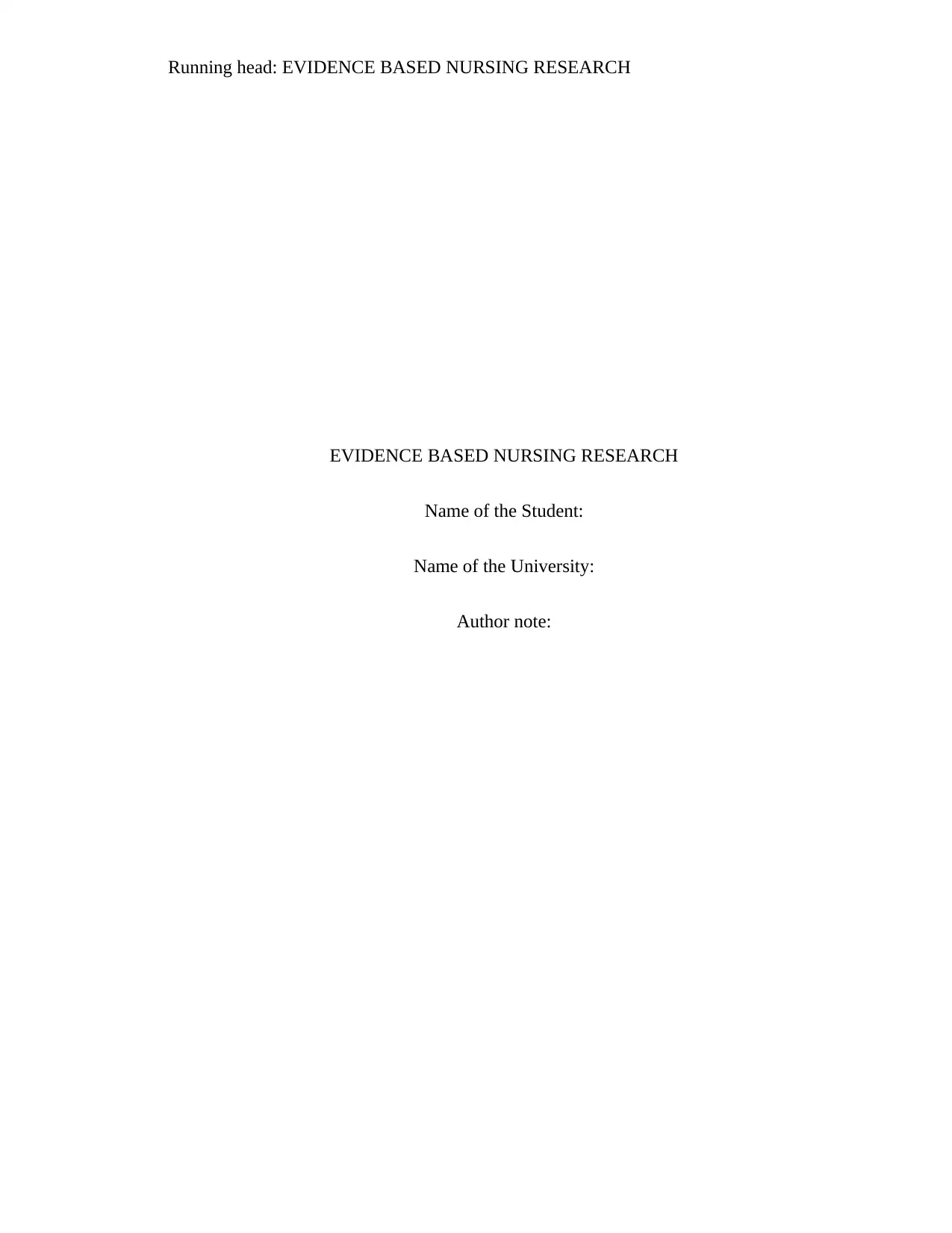
Running head: EVIDENCE BASED NURSING RESEARCH
EVIDENCE BASED NURSING RESEARCH
Name of the Student:
Name of the University:
Author note:
EVIDENCE BASED NURSING RESEARCH
Name of the Student:
Name of the University:
Author note:
Paraphrase This Document
Need a fresh take? Get an instant paraphrase of this document with our AI Paraphraser
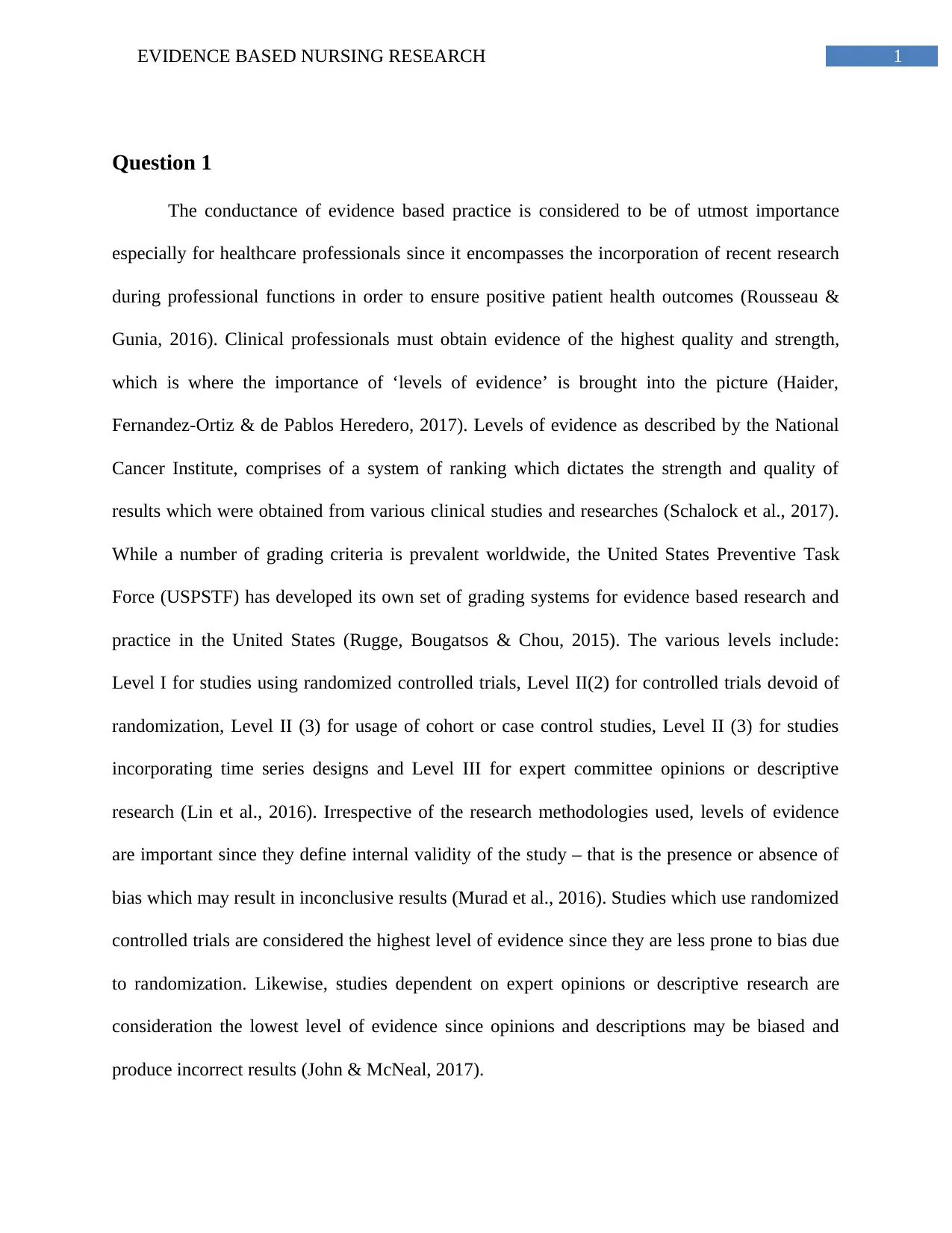
1EVIDENCE BASED NURSING RESEARCH
Question 1
The conductance of evidence based practice is considered to be of utmost importance
especially for healthcare professionals since it encompasses the incorporation of recent research
during professional functions in order to ensure positive patient health outcomes (Rousseau &
Gunia, 2016). Clinical professionals must obtain evidence of the highest quality and strength,
which is where the importance of ‘levels of evidence’ is brought into the picture (Haider,
Fernandez-Ortiz & de Pablos Heredero, 2017). Levels of evidence as described by the National
Cancer Institute, comprises of a system of ranking which dictates the strength and quality of
results which were obtained from various clinical studies and researches (Schalock et al., 2017).
While a number of grading criteria is prevalent worldwide, the United States Preventive Task
Force (USPSTF) has developed its own set of grading systems for evidence based research and
practice in the United States (Rugge, Bougatsos & Chou, 2015). The various levels include:
Level I for studies using randomized controlled trials, Level II(2) for controlled trials devoid of
randomization, Level II (3) for usage of cohort or case control studies, Level II (3) for studies
incorporating time series designs and Level III for expert committee opinions or descriptive
research (Lin et al., 2016). Irrespective of the research methodologies used, levels of evidence
are important since they define internal validity of the study – that is the presence or absence of
bias which may result in inconclusive results (Murad et al., 2016). Studies which use randomized
controlled trials are considered the highest level of evidence since they are less prone to bias due
to randomization. Likewise, studies dependent on expert opinions or descriptive research are
consideration the lowest level of evidence since opinions and descriptions may be biased and
produce incorrect results (John & McNeal, 2017).
Question 1
The conductance of evidence based practice is considered to be of utmost importance
especially for healthcare professionals since it encompasses the incorporation of recent research
during professional functions in order to ensure positive patient health outcomes (Rousseau &
Gunia, 2016). Clinical professionals must obtain evidence of the highest quality and strength,
which is where the importance of ‘levels of evidence’ is brought into the picture (Haider,
Fernandez-Ortiz & de Pablos Heredero, 2017). Levels of evidence as described by the National
Cancer Institute, comprises of a system of ranking which dictates the strength and quality of
results which were obtained from various clinical studies and researches (Schalock et al., 2017).
While a number of grading criteria is prevalent worldwide, the United States Preventive Task
Force (USPSTF) has developed its own set of grading systems for evidence based research and
practice in the United States (Rugge, Bougatsos & Chou, 2015). The various levels include:
Level I for studies using randomized controlled trials, Level II(2) for controlled trials devoid of
randomization, Level II (3) for usage of cohort or case control studies, Level II (3) for studies
incorporating time series designs and Level III for expert committee opinions or descriptive
research (Lin et al., 2016). Irrespective of the research methodologies used, levels of evidence
are important since they define internal validity of the study – that is the presence or absence of
bias which may result in inconclusive results (Murad et al., 2016). Studies which use randomized
controlled trials are considered the highest level of evidence since they are less prone to bias due
to randomization. Likewise, studies dependent on expert opinions or descriptive research are
consideration the lowest level of evidence since opinions and descriptions may be biased and
produce incorrect results (John & McNeal, 2017).
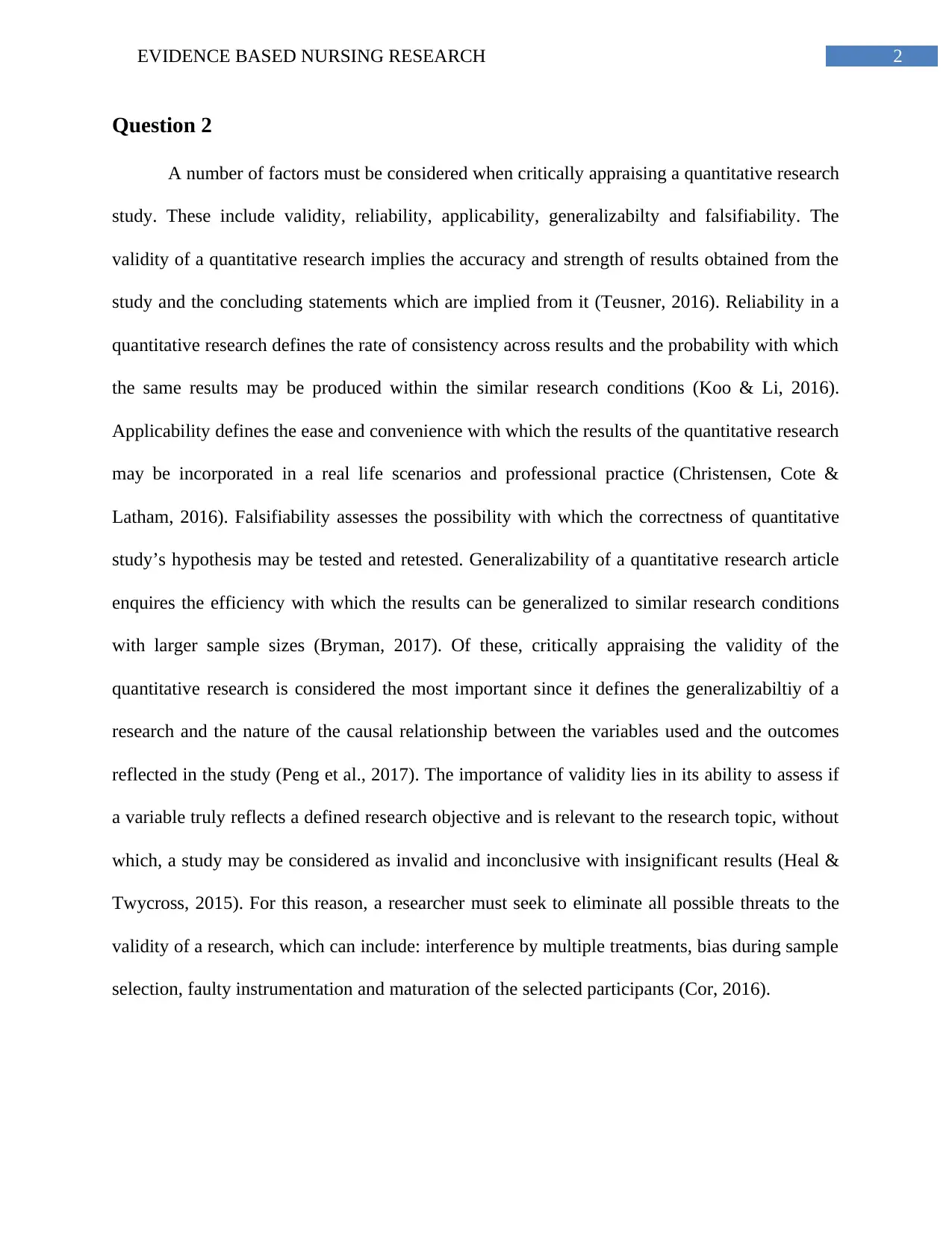
2EVIDENCE BASED NURSING RESEARCH
Question 2
A number of factors must be considered when critically appraising a quantitative research
study. These include validity, reliability, applicability, generalizabilty and falsifiability. The
validity of a quantitative research implies the accuracy and strength of results obtained from the
study and the concluding statements which are implied from it (Teusner, 2016). Reliability in a
quantitative research defines the rate of consistency across results and the probability with which
the same results may be produced within the similar research conditions (Koo & Li, 2016).
Applicability defines the ease and convenience with which the results of the quantitative research
may be incorporated in a real life scenarios and professional practice (Christensen, Cote &
Latham, 2016). Falsifiability assesses the possibility with which the correctness of quantitative
study’s hypothesis may be tested and retested. Generalizability of a quantitative research article
enquires the efficiency with which the results can be generalized to similar research conditions
with larger sample sizes (Bryman, 2017). Of these, critically appraising the validity of the
quantitative research is considered the most important since it defines the generalizabiltiy of a
research and the nature of the causal relationship between the variables used and the outcomes
reflected in the study (Peng et al., 2017). The importance of validity lies in its ability to assess if
a variable truly reflects a defined research objective and is relevant to the research topic, without
which, a study may be considered as invalid and inconclusive with insignificant results (Heal &
Twycross, 2015). For this reason, a researcher must seek to eliminate all possible threats to the
validity of a research, which can include: interference by multiple treatments, bias during sample
selection, faulty instrumentation and maturation of the selected participants (Cor, 2016).
Question 2
A number of factors must be considered when critically appraising a quantitative research
study. These include validity, reliability, applicability, generalizabilty and falsifiability. The
validity of a quantitative research implies the accuracy and strength of results obtained from the
study and the concluding statements which are implied from it (Teusner, 2016). Reliability in a
quantitative research defines the rate of consistency across results and the probability with which
the same results may be produced within the similar research conditions (Koo & Li, 2016).
Applicability defines the ease and convenience with which the results of the quantitative research
may be incorporated in a real life scenarios and professional practice (Christensen, Cote &
Latham, 2016). Falsifiability assesses the possibility with which the correctness of quantitative
study’s hypothesis may be tested and retested. Generalizability of a quantitative research article
enquires the efficiency with which the results can be generalized to similar research conditions
with larger sample sizes (Bryman, 2017). Of these, critically appraising the validity of the
quantitative research is considered the most important since it defines the generalizabiltiy of a
research and the nature of the causal relationship between the variables used and the outcomes
reflected in the study (Peng et al., 2017). The importance of validity lies in its ability to assess if
a variable truly reflects a defined research objective and is relevant to the research topic, without
which, a study may be considered as invalid and inconclusive with insignificant results (Heal &
Twycross, 2015). For this reason, a researcher must seek to eliminate all possible threats to the
validity of a research, which can include: interference by multiple treatments, bias during sample
selection, faulty instrumentation and maturation of the selected participants (Cor, 2016).
⊘ This is a preview!⊘
Do you want full access?
Subscribe today to unlock all pages.

Trusted by 1+ million students worldwide
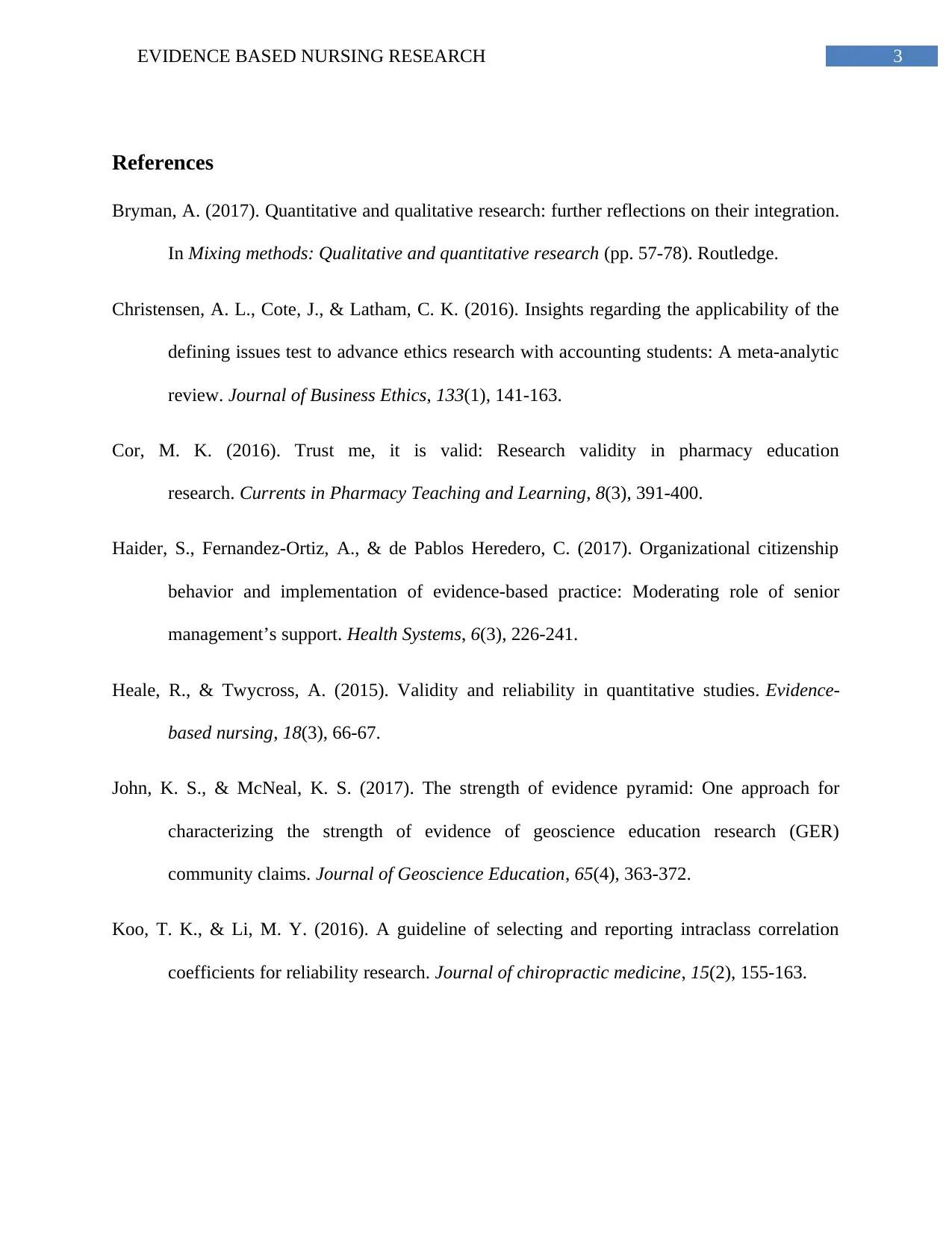
3EVIDENCE BASED NURSING RESEARCH
References
Bryman, A. (2017). Quantitative and qualitative research: further reflections on their integration.
In Mixing methods: Qualitative and quantitative research (pp. 57-78). Routledge.
Christensen, A. L., Cote, J., & Latham, C. K. (2016). Insights regarding the applicability of the
defining issues test to advance ethics research with accounting students: A meta-analytic
review. Journal of Business Ethics, 133(1), 141-163.
Cor, M. K. (2016). Trust me, it is valid: Research validity in pharmacy education
research. Currents in Pharmacy Teaching and Learning, 8(3), 391-400.
Haider, S., Fernandez-Ortiz, A., & de Pablos Heredero, C. (2017). Organizational citizenship
behavior and implementation of evidence-based practice: Moderating role of senior
management’s support. Health Systems, 6(3), 226-241.
Heale, R., & Twycross, A. (2015). Validity and reliability in quantitative studies. Evidence-
based nursing, 18(3), 66-67.
John, K. S., & McNeal, K. S. (2017). The strength of evidence pyramid: One approach for
characterizing the strength of evidence of geoscience education research (GER)
community claims. Journal of Geoscience Education, 65(4), 363-372.
Koo, T. K., & Li, M. Y. (2016). A guideline of selecting and reporting intraclass correlation
coefficients for reliability research. Journal of chiropractic medicine, 15(2), 155-163.
References
Bryman, A. (2017). Quantitative and qualitative research: further reflections on their integration.
In Mixing methods: Qualitative and quantitative research (pp. 57-78). Routledge.
Christensen, A. L., Cote, J., & Latham, C. K. (2016). Insights regarding the applicability of the
defining issues test to advance ethics research with accounting students: A meta-analytic
review. Journal of Business Ethics, 133(1), 141-163.
Cor, M. K. (2016). Trust me, it is valid: Research validity in pharmacy education
research. Currents in Pharmacy Teaching and Learning, 8(3), 391-400.
Haider, S., Fernandez-Ortiz, A., & de Pablos Heredero, C. (2017). Organizational citizenship
behavior and implementation of evidence-based practice: Moderating role of senior
management’s support. Health Systems, 6(3), 226-241.
Heale, R., & Twycross, A. (2015). Validity and reliability in quantitative studies. Evidence-
based nursing, 18(3), 66-67.
John, K. S., & McNeal, K. S. (2017). The strength of evidence pyramid: One approach for
characterizing the strength of evidence of geoscience education research (GER)
community claims. Journal of Geoscience Education, 65(4), 363-372.
Koo, T. K., & Li, M. Y. (2016). A guideline of selecting and reporting intraclass correlation
coefficients for reliability research. Journal of chiropractic medicine, 15(2), 155-163.
Paraphrase This Document
Need a fresh take? Get an instant paraphrase of this document with our AI Paraphraser
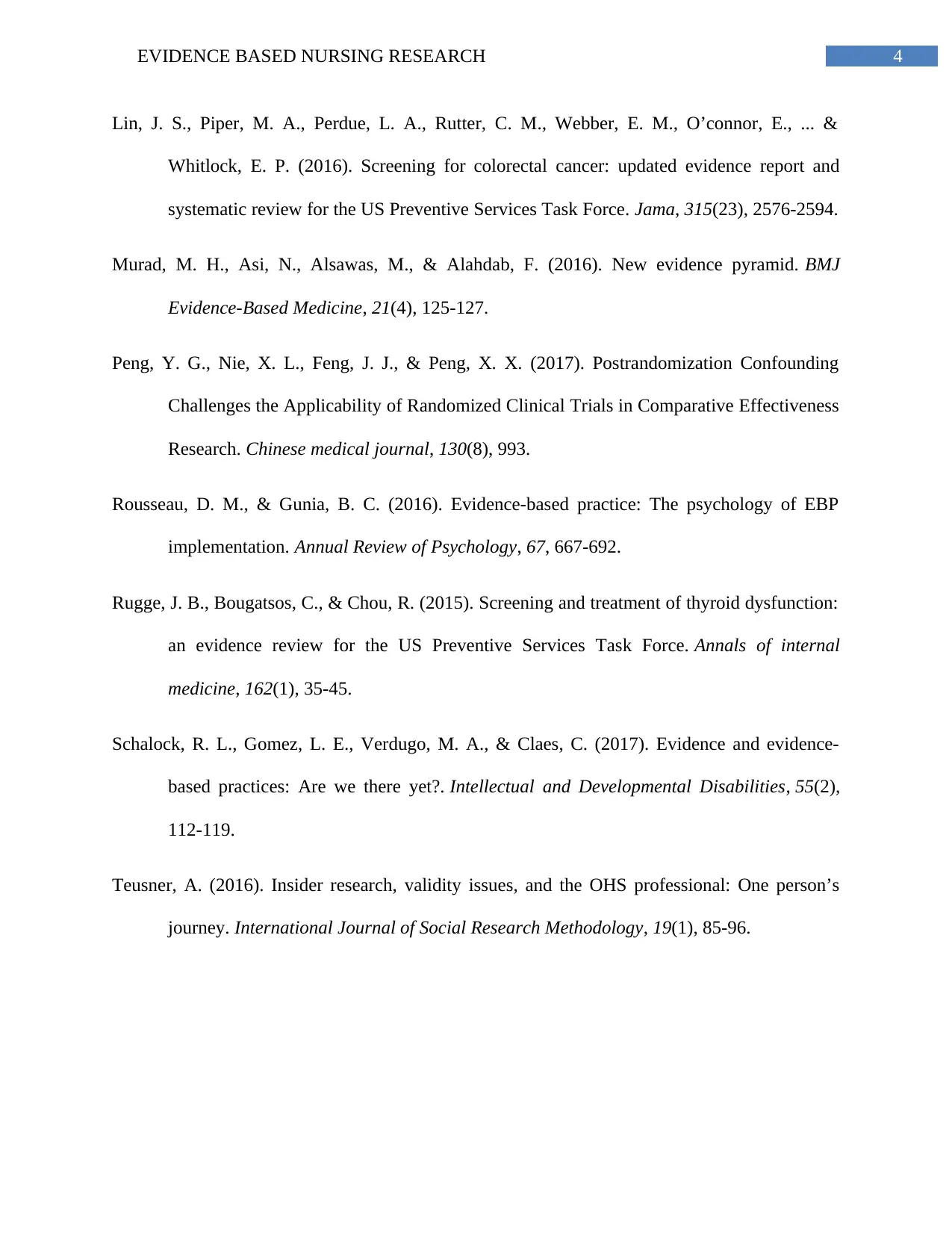
4EVIDENCE BASED NURSING RESEARCH
Lin, J. S., Piper, M. A., Perdue, L. A., Rutter, C. M., Webber, E. M., O’connor, E., ... &
Whitlock, E. P. (2016). Screening for colorectal cancer: updated evidence report and
systematic review for the US Preventive Services Task Force. Jama, 315(23), 2576-2594.
Murad, M. H., Asi, N., Alsawas, M., & Alahdab, F. (2016). New evidence pyramid. BMJ
Evidence-Based Medicine, 21(4), 125-127.
Peng, Y. G., Nie, X. L., Feng, J. J., & Peng, X. X. (2017). Postrandomization Confounding
Challenges the Applicability of Randomized Clinical Trials in Comparative Effectiveness
Research. Chinese medical journal, 130(8), 993.
Rousseau, D. M., & Gunia, B. C. (2016). Evidence-based practice: The psychology of EBP
implementation. Annual Review of Psychology, 67, 667-692.
Rugge, J. B., Bougatsos, C., & Chou, R. (2015). Screening and treatment of thyroid dysfunction:
an evidence review for the US Preventive Services Task Force. Annals of internal
medicine, 162(1), 35-45.
Schalock, R. L., Gomez, L. E., Verdugo, M. A., & Claes, C. (2017). Evidence and evidence-
based practices: Are we there yet?. Intellectual and Developmental Disabilities, 55(2),
112-119.
Teusner, A. (2016). Insider research, validity issues, and the OHS professional: One person’s
journey. International Journal of Social Research Methodology, 19(1), 85-96.
Lin, J. S., Piper, M. A., Perdue, L. A., Rutter, C. M., Webber, E. M., O’connor, E., ... &
Whitlock, E. P. (2016). Screening for colorectal cancer: updated evidence report and
systematic review for the US Preventive Services Task Force. Jama, 315(23), 2576-2594.
Murad, M. H., Asi, N., Alsawas, M., & Alahdab, F. (2016). New evidence pyramid. BMJ
Evidence-Based Medicine, 21(4), 125-127.
Peng, Y. G., Nie, X. L., Feng, J. J., & Peng, X. X. (2017). Postrandomization Confounding
Challenges the Applicability of Randomized Clinical Trials in Comparative Effectiveness
Research. Chinese medical journal, 130(8), 993.
Rousseau, D. M., & Gunia, B. C. (2016). Evidence-based practice: The psychology of EBP
implementation. Annual Review of Psychology, 67, 667-692.
Rugge, J. B., Bougatsos, C., & Chou, R. (2015). Screening and treatment of thyroid dysfunction:
an evidence review for the US Preventive Services Task Force. Annals of internal
medicine, 162(1), 35-45.
Schalock, R. L., Gomez, L. E., Verdugo, M. A., & Claes, C. (2017). Evidence and evidence-
based practices: Are we there yet?. Intellectual and Developmental Disabilities, 55(2),
112-119.
Teusner, A. (2016). Insider research, validity issues, and the OHS professional: One person’s
journey. International Journal of Social Research Methodology, 19(1), 85-96.
1 out of 5
Related Documents
Your All-in-One AI-Powered Toolkit for Academic Success.
+13062052269
info@desklib.com
Available 24*7 on WhatsApp / Email
![[object Object]](/_next/static/media/star-bottom.7253800d.svg)
Unlock your academic potential
Copyright © 2020–2025 A2Z Services. All Rights Reserved. Developed and managed by ZUCOL.





